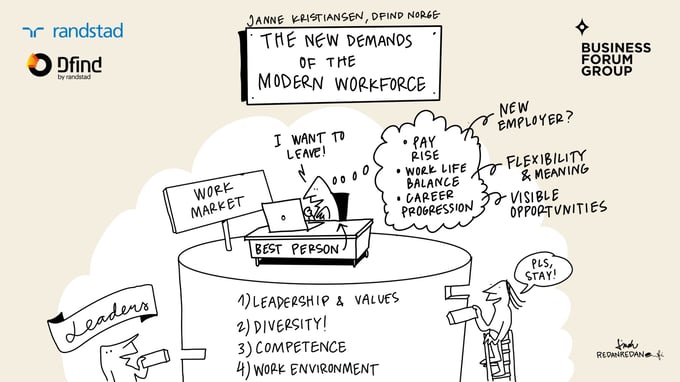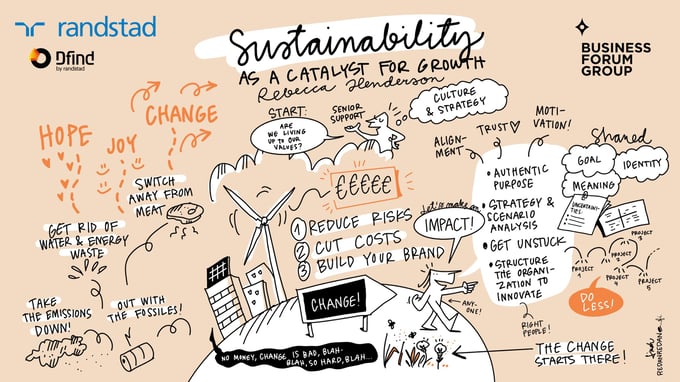Award-winning Harvard Professor Rebecca Henderson is a global authority on sustainable business growth. In our latest webinar, in cooperation with our partner Dfind, she discussed how to make sustainability a catalyst for growth and innovation in organizations.
Did you miss the webinar? Don't worry. The webinar recordings are available until 13 June 2023 through the sign-up page. If you haven't signed up yet, you can do so here.
How to meet the new demands of the modern workforce with Dfind Norway
Before Rebecca’s insights, we heard from our webinar partner Dfind Norway. National Director, Janne Kristiansen, shared her knowledge on how to meet the demands of the new workforce. She pointed out that the modern workforce is undergoing significant changes, and leaders need to adapt to meet the new demands.
Janne highlighted three major factors influencing the current workforce. Firstly, the prospect of a pay raise is highly motivating as the cost of living increases. However, leaders often believe that candidates have overly high salary expectations compared to their competence. Secondly, work-life balance has become a crucial consideration due to recent global economic unrest. Candidates seek companies that offer flexibility, autonomy, and purpose, and leaders should emphasize these aspects during recruitment and onboarding. Lastly, career progression is essential for both employees and the company’s success. Leaders should communicate clear career opportunities to attract and retain talent.
In addition to these factors, Janne provided four top tips for meeting the new demands of the modern workforce:
-
Value-driven leadership is crucial, as employees want their personal values to align with their workplace
-
Diversity and inclusion are important, as companies with diverse employees are more likely to perform better
-
Investing in competency development from within the organization helps recruit and retain employees while avoiding high turnover costs
-
A great work environment is the number one factor employees consider when changing jobs, and leaders should showcase their work environment and prioritize its improvement
 Visual Summary of intro speech by Janne Kristiansen, National Director of Dfind Norge
Visual Summary of intro speech by Janne Kristiansen, National Director of Dfind Norge
Rebecca Henderson: Making Sustainability a Catalyst for Growth and Innovation
Rebecca’s presentation emphasized the role of sustainability as a catalyst for growth and innovation. She began by stating, “How do you use sustainability as a catalyst for growth? Well, the good news is that sustainability is going to be the biggest change to the economy that we have seen in 20 years apart from AI and biotech.”
She highlighted the magnitude of this transformation and its impact on various industries such as energy, agriculture, food, construction, and finance. To illustrate her points, she showed us a slide that visualized how disruptions happen in industries. Industries and trends start off small and mysterious, then they take off and reach maturity, and at that point, disruptions start to happen. Sustainability is one of those disruptions, and it’s going to transform more than half of the global economy.
There’s a lot of money to be made
The good news is, as Rebecca pointed out, that there’s a lot of money to be made from this disruption and transformation. She introduced us to four basic business cases that support the integration of sustainability in business:
Reduce risks
Anything that can reduce your business risk in this volatile environment is going to be helpful. Rebecca gave the example of Iberdrola, one of the largest electric utility companies in Europe. They invested in renewable energy very early on, along with a handful of competitors, which secured them the top spot in the market today. If you can find ways to reduce risk in this changing world, you’re on the right track.
Cut costs
Transitioning away from fossil fuels and cutting energy use not only helps the environment but also saves you money. Walmart is a great example, as they achieved about a billion dollars in savings by improving the efficiency of their transportation fleet. They cut annual GHG emissions by 23% while making money the entire time and increasing profitability.
Build your brand
Building a strong brand that aligns with the values of consumers is important and profitable. The younger generations and many individuals seek to support companies that demonstrate a commitment to sustainability. Rebecca mentioned companies like H&M, which have introduced new brand names to emphasize their sustainability efforts.
Create entirely new businesses
Opportunities emerge in areas such as battery storage and plant-based food products. The Korean conglomerate SK and food brand Impossible Burger are prime examples of capitalizing on sustainable innovations. There are huge opportunities in agriculture and food, as these industries have a significant effect on our ability to fulfill global sustainability targets.
“It’s so easy to think, well, I can’t do well, can’t do good for the world and make money. But believe me, you can.”
Overcome Resistance
“Of course, change is never easy,” Rebecca continued. It’s instinctive for us to think that the change that everyone is talking about won’t happen, at least not right now, because it’s inconvenient for us. Big changes also face resistance because of a lack of confidence. It is easy to think that change won’t make money or that it can’t even be done. For change to be implemented, you need to prove that it’s necessary, stick to it long-term, and create a convincing business case.
Leaders play a crucial role in integrating sustainability into the company strategy. This is more than issuing a statement because your employees and customers will see through greenwashing, which can create cynicism and even contempt. Leaders need to decide where to start and what projects and actions to take to show that sustainability is integrated into the company’s values and strategy.
“Show that you really care about sustainability and that it’s integral to your values. And at the same time, how are you going to persuade the organization to come with you, and how are you going to organize for innovation?"
Organizational Approach to Innovation
Sustainability requires a collective effort, and the whole organization needs to be involved. This can be thought of as any other change process. However, it’s good to remember that as the world keeps changing, you will be managing multiple change initiatives at once. Rebecca presented four ideas that can help us create organizational innovation and change:
Use authentic purpose as your secret weapon
An authentic purpose is something that you and your company are willing to take risks for, invest in, and make difficult decisions on. Having a strong authentic purpose supports three things in your workforce: shared vision and belief, meaning and authenticity, and shared identity. These factors ensure that the people in your organization work to make a difference, are proud of what they do, care about each other and the world, and are committed to the organization and the people around them. These three qualities create strategic alignment, intrinsic motivation, and trust, which can, in turn, lead to good performance.
Use scenario analysis
Authentic purpose needs to be linked with strategy in order to improve performance. And to build a strategy, you can use scenario analysis. Bring your team together and discuss the things that might change in the world and can greatly impact your business. Create a list of these critical uncertainties and use them to draw a map of what the different possible outcomes are, and how probable each one is. Then, discuss how each scenario impacts your business and what should be done about it.
Get unstuck
Do you have so many things going on at the same time in your organization that it seems like nothing gets done? Productivity drops dramatically when one person has to partake in multiple projects at the same time. On average, research has found that two projects at the same time are the optimal number for peak productivity. By doing less and reducing the commitments of the company, you and your employees will get unstuck and actually get things done.
Structure the organization to innovate
Rebecca pointed out that, in general, there are three different types of innovations: improving existing designs, improving operations, and doing disruptive innovation. All types of innovation require different resources, leadership, incentives, and people. Companies often see innovations as just one thing and manage it on a quarterly or yearly basis, like any goal. However, this usually does not work. Different kinds of innovation need to be approached differently, and Rebecca recommends creating a separate team to explore them.
“Sustainability is a huge strategic opportunity, but it requires learning to change.”
 Visual Summary of 'Sustainability as a Catalyst for Growth & Innovation'. Graphics by Linda Saukko-Rauta
Visual Summary of 'Sustainability as a Catalyst for Growth & Innovation'. Graphics by Linda Saukko-Rauta
Award-winning Harvard Professor Rebecca Henderson is a keynote speaker at OBForum 2023, 26-27 September on 'Reimagining Capitalism in a World on Fire'.
What you will learn from her:
-
A pragmatic roadmap for how business can help to catalyze the systemic change we need to build a capitalism that works for everyone.
-
Henderson’s deep understanding of how change takes place, combined with fascinating in-depth stories of companies that have made the first steps towards reimagining capitalism, provides inspiring insight into what capitalism can be.
-
Henderson provides the pragmatic foundation for navigating a world faced with unprecedented challenge, but also with extraordinary opportunity for those who can get it right.
75% of our tickets have already been sold and less than 50 VIP tickets are left. Don't miss out to join Rebecca live on stage and save your tickets now. Our ticket prices increase on Friday, 16 June, 4 PM (CET)!

.png?width=680&name=CTA_2023%20(2).png)